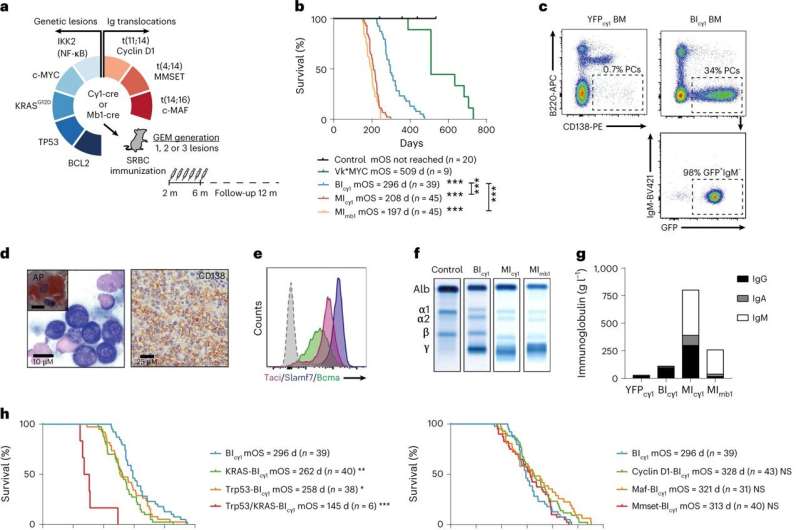This article has been reviewed according to Science X's editorial process and policies. Editors have highlighted the following attributes while ensuring the content's credibility:
fact-checked
trusted source
proofread
Scientists create mouse avatars to treat multiple myeloma

An international group of researchers, led by Dr. José Ángel Martínez-Climent at the Cima University of Navarra, has created mouse avatars of patients with multiple myeloma to study and develop personalized treatments against this blood cancer, the second most frequent hematological cancer and incurable in most cases. These artificial mice can mimic the genetic and immunological diversity of the origin and evolution of this disease in patients. This advance will allow researchers to design more effective and personalized therapies for multiple myeloma.
Nature Medicine has published this study, which opens a pathway for research into other non-curable hematological and solid tumors.
Hospitals, research centers, and biotechnology and pharmaceutical companies from Spain, Switzerland, United States, and Japan have also participated in this multicenter study. The leading researchers of the project are part of the Cancer Center Clínica Universidad de Navarra and belong to the Centro de Investigación Biomédica en Red en Cáncer (CIBERONC) and the Instituto de Investigación Sanitaria de Navarra (IdiSNA)
A multiple myeloma 'catalog' to improve its treatment
Multiple myeloma is a blood cancer that occurs in the bone marrow. It is caused by the proliferation of plasma cells, immune cells responsible for producing antibodies. It is a heterogeneous disease, meaning that it can present in different ways and have different responses to treatment.
To meet the medical need for new treatments to cure the disease, the researchers have used genetic engineering and multi-omic cellular and molecular technologies to analyze more than 500 genetically heterogeneous mice that develop multiple myeloma and tumor cells from more than 1,000 patients with the disease. These samples are from patients attended in the Hematologic Cancer Area of the Cancer Center Clínica Universidad de Navarra.
Thanks to this analysis, "we have generated artificial mice that accurately reflect key aspects of the origin and development of multiple myeloma in humans. This allows us to study the progression of the disease, test therapeutic alternatives and predict the response to combinations of immunotherapy drugs in the clinic," says Marta Larrayoz, a researcher in the Hemato-Oncology Program at Cima University of Navarra and first author of the study.
Significant implications for patients
Researchers must be able to contrast and validate the information provided by preclinical models with patient data to advance laboratory work. "Thanks to our ongoing collaboration with the hematologists at the Cancer Center Clínica Universidad de Navarra, we have identified in our mouse models of multiple myeloma a correlation between the genetic and immunological traits of each tumor and its selective response to preclinical therapies," says José Ángel Martínez-Climent, principal investigator and coordinator of the study, also belongs to the Cima Hemato-Oncology Program.
This research will allow researchers to anticipate treatment outcomes with next-generation immunotherapies and mimic in the laboratory clinical situations associated with the worst outcomes, such as high-risk multiple myeloma, extramedullary disease, or acquired therapeutic resistance. "This scenario offers us opportunities to advance in the investigation of new therapeutic strategies and to optimize the design of future immunotherapy clinical trials," says Martínez-Climent.
"We are testing novel therapies in experimental models at stages of the disease where multiple myeloma cells might be most vulnerable, particularly in early precursor conditions or in the minimal residual disease state (after treatment, when few tumor cells remain). To do this, we have established numerous scientific collaborations with pharmaceutical companies developing clinical trials in this disease to carry out these same trials in our mice," Martínez-Climent adds.
The ultimate goal, say the researchers, "is to transfer the discoveries from the laboratory to the clinic and that research initiatives such as ours can be extrapolated to other hematological malignancies and solid tumors that remain incurable with currently available treatments."
More information: Marta Larrayoz et al, Preclinical models for prediction of immunotherapy outcomes and immune evasion mechanisms in genetically heterogeneous multiple myeloma, Nature Medicine (2023). DOI: 10.1038/s41591-022-02178-3





















